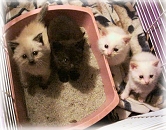Here are general guidelines for kittens' stages of development: Birth to Two Weeks: Neonatal Period
Two to Seven Weeks: Socialization Period
Seven to Fourteen Weeks: Most Active Play Period
Three to Six Months: Ranking Period * Kitten is most influenced by her "litter," which may now include playmates of other species. Six to Eighteen Months: Adolescence
©2002. Adapted from material originally developed by applied animal behaviorists at the Dumb Friends League, Denver, Colorado. All rights reserved. Kitten Misbehaving?House Soiling House soiling is the most common behavior problem reported by cat owners. It includes urination and/or defecation outside the litter box, as well as urine spraying. Why do cats eliminate outside of the litter box? Medical Problems In addition, kidney, liver, and thyroid diseases often lead to increased drinking and urination. Inflammation of the colon or rectum, intestinal tract tumors, intestinal parasites, and other gastrointestinal conditions may cause painful defecation, increased frequency or urgency to defecate, and decreased control of defecation. Age-related diseases that interfere with a cat's mobility (for example, arthritis, nervous system disorders, or muscular diseases), or with his cognitive functions can also influence his ability to get to the litter box in time. In short, any medical condition that interferes with a cat's normal elimination behavior can lead to house soiling. Litter Box Aversions Something about the litter box bothers your cat.
Cats with aversions usually eliminate on varying surfaces. You may find puddles of urine and/or feces on either soft surfaces like carpets, beds, or clothing, or on hard, shiny surfaces like tile floors or bathtubs. Depending on the severity of your cat's aversion, he may continue to use the litter box, but only inconsistently. Urine Spraying When your cat rubs against your leg with his face, or scratches his scratching post, he is also depositing his scent from the glands in his cheeks and paws. Another equally normal but less pleasant marking behavior is urine spraying--the deposition of small amounts of urine around a given area. Spraying announces a cat's presence, establishes or maintains territorial boundaries, and advertises sexual availability. Cats usually spray on vertical surfaces, like the backs of chairs, or walls. They don't squat to spray (as they do to urinate), but the tail lifts and quivers, and small puddles of urine are left in several consistent locations. Cats that spray are usually unneutered males and, to a lesser extent, unspayed females, but 10% of neutered males and 5% of neutered females also spray. In households with more than seven cats, the likelihood of spraying is high. Cats may spray when they perceive a threat to their territory, such as when a new cat enters the home, or when outside cats are nearby. New furniture and carpet smells can prompt spraying as well. Cats may also spray out of frustration resulting from factors—like restrictive diets, or insufficient playtime—often wrongly perceived by humans as revenge.
|


Baby Kitten Home New Baby Kitten Baby Kitten Handling Baby Kitten Basics Kitten Diseases Kitten's Future Kitten Articles Kitten Corner Resources:
|
|
|||
|
|
Finding the right Kitten - Kitten or Cat? - Adopt a Cat for Life - Kitten Development - Kitten Age - Kitten Formula Recipe - Kitten Diet - Kitten Tips - Potty the Kitten - Kitten Hydration - Rehydrate the Kitten - Conjunctivitis - Runny Eyes - Eye Infections - Eye Discharge - Third Eyelid - Feline Infectious Diseases - (FIV) - (FeLV) - (FIP) - Feline Aids - Feline Leukemia - Rabies Vaccine - Feline Herpes Virus - Feline Distemper - Kitten Health Dangers - Kitten Ilnesses - Kitten Diseases - Preventative Care - Spaying and Neutering - Fixing - How to play with your Kitten - Kitten Toys - Kitten Bonding - Coccidial Infections (Coccidia) - Giardia - Cryptosporidium - Toxoplasmosis - Roundworms - Hookworms - Tapeworms - Pinworms - Whipworms - Fleas - Ticks - Ear mites - Injuries - Sneezing - Poisonous Plants - Cute Kitten Videos |
|
Webdesign and Photos by SmilingPages.com in Support of the Rainbow Wildlife Rescue - Privacy Policy |
